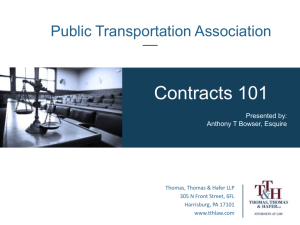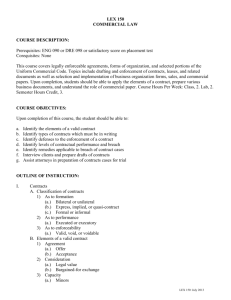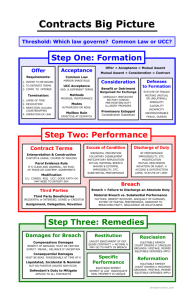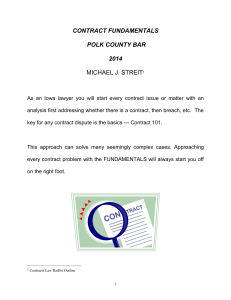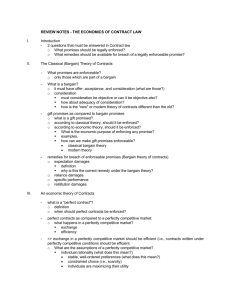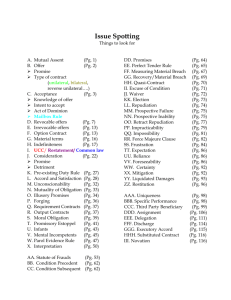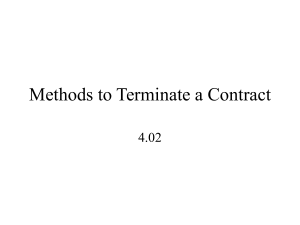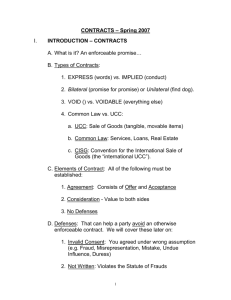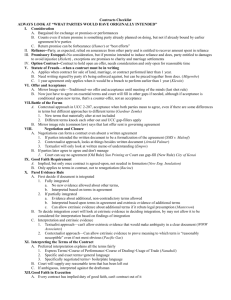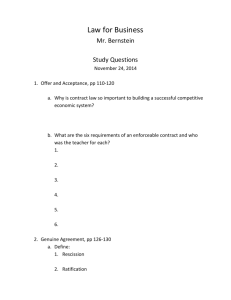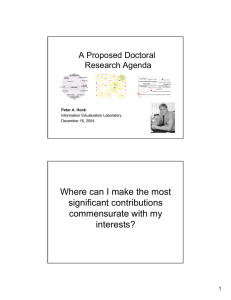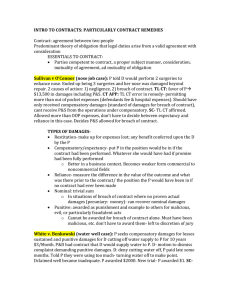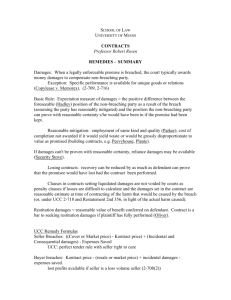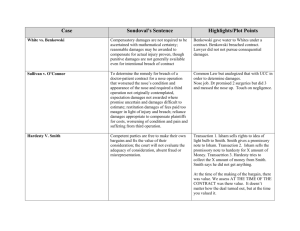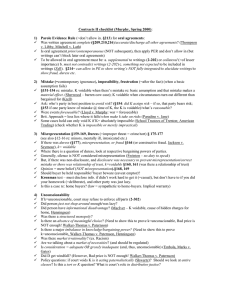Lesson Plan
advertisement
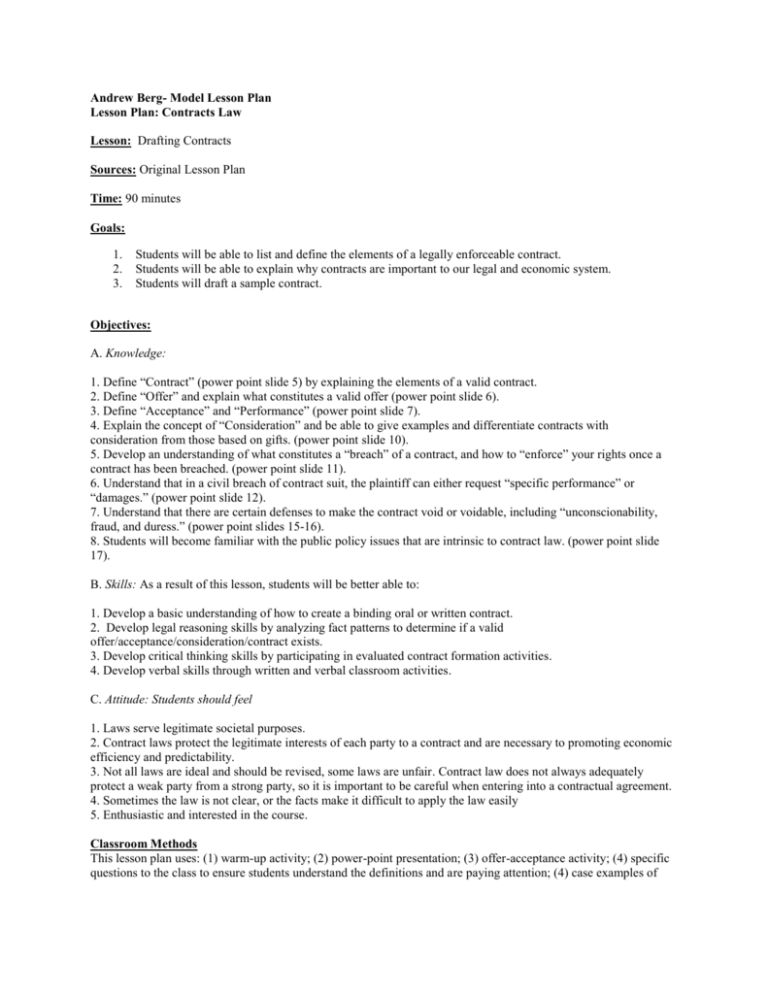
Andrew Berg- Model Lesson Plan Lesson Plan: Contracts Law Lesson: Drafting Contracts Sources: Original Lesson Plan Time: 90 minutes Goals: 1. 2. 3. Students will be able to list and define the elements of a legally enforceable contract. Students will be able to explain why contracts are important to our legal and economic system. Students will draft a sample contract. Objectives: A. Knowledge: 1. Define “Contract” (power point slide 5) by explaining the elements of a valid contract. 2. Define “Offer” and explain what constitutes a valid offer (power point slide 6). 3. Define “Acceptance” and “Performance” (power point slide 7). 4. Explain the concept of “Consideration” and be able to give examples and differentiate contracts with consideration from those based on gifts. (power point slide 10). 5. Develop an understanding of what constitutes a “breach” of a contract, and how to “enforce” your rights once a contract has been breached. (power point slide 11). 6. Understand that in a civil breach of contract suit, the plaintiff can either request “specific performance” or “damages.” (power point slide 12). 7. Understand that there are certain defenses to make the contract void or voidable, including “unconscionability, fraud, and duress.” (power point slides 15-16). 8. Students will become familiar with the public policy issues that are intrinsic to contract law. (power point slide 17). B. Skills: As a result of this lesson, students will be better able to: 1. Develop a basic understanding of how to create a binding oral or written contract. 2. Develop legal reasoning skills by analyzing fact patterns to determine if a valid offer/acceptance/consideration/contract exists. 3. Develop critical thinking skills by participating in evaluated contract formation activities. 4. Develop verbal skills through written and verbal classroom activities. C. Attitude: Students should feel 1. Laws serve legitimate societal purposes. 2. Contract laws protect the legitimate interests of each party to a contract and are necessary to promoting economic efficiency and predictability. 3. Not all laws are ideal and should be revised, some laws are unfair. Contract law does not always adequately protect a weak party from a strong party, so it is important to be careful when entering into a contractual agreement. 4. Sometimes the law is not clear, or the facts make it difficult to apply the law easily 5. Enthusiastic and interested in the course. Classroom Methods This lesson plan uses: (1) warm-up activity; (2) power-point presentation; (3) offer-acceptance activity; (4) specific questions to the class to ensure students understand the definitions and are paying attention; (4) case examples of each topic discussed; and (5) written evaluation at the end of class which requires students to work in groups to draft an oral or written contract. 1. Do Now Warm-up [5 minutes writing, 3 minutes discussion] At the beginning of class, the students will answer two warm-up questions from a power point slide on their own paper. a. List the things you think you would need to have in a contract for it to be valid. b. Describe a contract that you have been in, or one that you have heard about. What made it a contract? c. Introduction- [3 minutes] First, students will see the day’s objectives on the power point. We will proceed by explaining what we mean by a “contract” using power point. We first give a technical definition and then break it down into its basic elements. 2. Offer and Acceptance Activity: [5 minutes for notes/discussion, 9 minutes for activity] a. b. c. 3. Introduction to Consideration[5 minutes for notes and discussion] Teachers will introduce the concept of consideration through a power point presentation. Students will receive a handout with summary definitions. a. b. c. 4. Brief overview of the purpose of consideration; Explain the difference between valid consideration and a gift/promise Students have the opportunity to give examples of valid/invalid consideration. Introduction to enforcement and breach:[5 minutes for notes and discussion] a. b. c. 5. Pass out a hand out with examples of fact patterns, which have the power point definitions of offer and acceptance on the top. Students must determine whether there is a valid offer, and or a valid acceptance and give a brief explanation for their reasoning. Students will work in pairs to complete the worksheet, allotting about 8 minutes for this activity. We will then go over the hand out as a class, asking one student from each group to volunteer their answer and reasoning, and students are welcome to respectfully debate if they do not agree. Explain what is meant by “specific performance” and why it is not always available as a remedy Explain the purpose of “damages” and what factors are taken into consideration in awarding damages (by either a judge or jury). Class should brainstorm some possibilities. (scope of the injury, ability to compensate with money, how can the law make the plaintiff “whole?” Discuss the public policy ramifications of damages: Does the likelihood of damages deter people from breaking their agreements? What if it is cheaper to break a contract and pay the damages than to perform the contract? Breach of Contract Activity: [10 minutes for breakout activity, 5 minutes to discuss as a group] a. Students will read a fact pattern in groups and determine whether or not they think either party breached the contract, and if so whether or not the court should make a party pay damages or specifically perform the contract. b. c. 6. Share the “Hairy Hand” case with the students as an example of how the court has determined damages in the past. (power point slide 14). Teachers circulate and give feedback. Introduce Defenses: [5 minutes for notes and discussion] a. b. Using Power Point, go over defenses to contract enforcement, including unconscionability, fraud and duress, as well as public policy/criminality defenses. (power point slide 17). If there is time, students may discuss what kinds of public policy the state should promote in enforcing contracts. Potential discussion topics include: “One-Click” signatures online, standard form contracts for tickets, cars, etc. Do people really have a choice in entering into retail contracts? Student loans? 7. Defenses Activity: [5 minutes for breakout activity, 5 minutes to discuss] a. Have one member of each table read the following facts out loud, then discuss whether the contract should be declared void for any of the reasons discussed above. b. Each group will discuss the issues, but is not required to write them down. We will hear each group’s opinion at the end. 8. Evaluation Contract Drafting Activity: [25 minutes to complete activity and turn in final product] a. The class will be divided into six groups by seating arrangement. b. Each group will be given a fact pattern, and will have to negotiate an oral or written contract. c. The students will hand in their contract at the end of class for an evaluation grade. Each group should have no more than 5 students. d. Teachers will circulate, remind students to integrate the concepts from the class, and actively give suggestions on how to improve the contract. Evaluation: 1. Participation in class activities (students receive check marks next to their name based on participation) 2. Written Contract Evaluation (handout). Students will receive a grade on the quality of their in-class work. It will follow the class grading rubric where substantial in-class assignments can receive a maximum of 10 points. Assignments: 1. Complete the homework handout, and answer all questions including the reflection question on the back. This handout introduces the next topic, tort law.
